 |
|
|
| 887 - c.914 |
Theophylact / Theophylactus |
Prince, Consul, and Senator ofRome. Count of Tusculum. |
| 887 - c.914 |
Theodora |
Wife and senatrix. |
| 897 |
Perhaps acting under pressure from the powerful Spoleto family, Pope Stephen convenes the Cadaver Synod, in which the corpse of Pope Fromosus is disinterred, dressed in papal robes, and tried on various charges. |
|
| 904 |
This is a period in which powerful women of the nobility play politics and influence papal rule inRome, and one in which a dominating civil power emerges in the city, typified by the Theophylactii. Senator Theophylact, count of Tusculum, and his wife, Senatrix Theodora (said to be the mistress of Pope John X), are the parents of Marozia. She is reputedly the concubine of Pope Sergius and gives birth to a son (the later Pope John XI). She also succeeds her father in being the power behind the papal 'throne'. Marozia is married to Alberic I of Spoleto, increasing her influence and allowing their son, Senator Alberic II, to continuing the numbering in AD 932 that had started with the dukes of Spoleto. 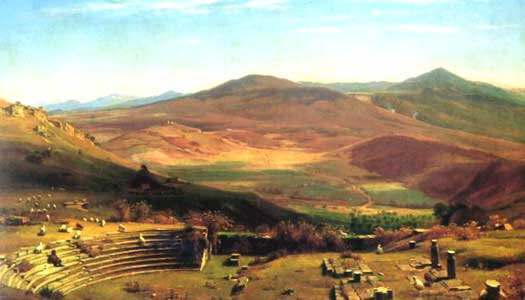 This romantic painting shows the amphitheatre of the Italian city of Tusculum, native territory of the influential counts of Tusculum who dominated the early post-Frankish Roman civil authority This romantic painting shows the amphitheatre of the Italian city of Tusculum, native territory of the influential counts of Tusculum who dominated the early post-Frankish Roman civil authority |
|
| 914 - 931 |
Marozia |
Dau. Lady ofRome. Died 945. |
| 914 - 922 |
Alberic I |
Husband. Duke of Spoleto. |
| 915 - 928 |
As the latest in a series of conflicts with the Saracens, Pope John X leads the Christian League of various Italian states into the Battle of Garigliano, a drawn-out combination of fights and a siege. The Saracens find themselves in a worsening situation and eventually attempt to flee, only to be captured and killed. In 928, the pope himself is killed through the machinations of Lady Marozia. |
|
| 932 - 954 |
Alberic II |
Son of Marozia & Alberic I, 'Prince & Senator of the Romans'. |
| 936 |
The power of Lady Marozia, daughter of Prince Theophylact, and her mother over the papal office is succeeded by that of Marozia's son, Alberic II, who elects several popes in succession. His son goes one step further when in 955, acting on his late father's wishes, he becomes Pope himself. |
|
| 954 |
Pope Agapetus is a surprisingly strong-willed pope for this period. He appeals to the king of theSaxons, Otto I, to end the stranglehold of Prince Alberic II over the papacy. The appeal has little immediate effect, until after Otto becomes Holy Roman Emperor. |
|
| 954 - 963 |
Octavianus / Ottaviano |
Son. Prince of Rome.Pope John XII (955-964). |
| 963 - 964 |
Following on from a previous appeal fromPope Agapetus II to free the papacy from outside control, Holy Roman Emperor Otto I arrives in Rome, taking direct control of the city where he has Pope John accused in an ecclesiastical court. The pope is deposed and replaced, but in his other guise as Octavianus he is powerful enough to have Otto's representatives mutilated and himself reinstated. |
|
| 964 - 965 |
Pope John's control of Rome is short-lived, as he dies soon afterwards. Benedict V is elected, but is deposed after just a month by former Anti-pope Leo VIII. |
|
| 965 - 966 |
Pope John XIII is accepted byHoly Roman Emperor Otto I but not by Rome. A revolt against him sees him temporarily banished from the city between December 965 to November 966, and a populist government rules in Rome. His successor is also supported by Otto, but not by the most powerful family of Rome, the descendants of Consul Theophylact, count of Tusculum. |
|
| 966 - 972 |
Holy Roman Emperor Otto I remains in direct control ofRome for much of his lifetime. In 973, Crescentius of the powerful Crescentii family becomes dominant, opponent of the Theophylactii in the struggle for the control of Rome. |
|
| 973 - 985 |
Crescentius I |
Grandson of Theophylact. Consul ofRome from 980. |
| 974 |
The untimely death ofPope Benedict VI is apparently at the hands of Anti-pope Boniface, on the orders of Crescentius I. Boniface flees to Constantinople, capital of the Eastern Roman empire, following the subsequent public outcry. The Crescentii are able to offer their own replacement, Benedict VII, son of David, who himself is the brother of Alberic II. He is elected by the imperial representative ofHoly Roman Emperor Otto II along with the clergy and people of Rome. |
|
| 984 - 985 |
Anti-pope Boniface VII returns to Rome in 984, and murders the unpopular Pope John XIV. He seizes the papal office for a short period before he himself seems to fall victim to assassination in 985. Little is known of this period in Rome, reflecting the political uncertainty in the region following the death ofHoly Roman Emperor Otto II. However, the presence in Rome of Empress Theophanu, mother and regent of Otto III, helps to stabilise the situation during the office of John XV. |
|
| 985 |
Giovanni Crescenzio I |
Consul ofRome. Restored in 996. |
| 985? - 996 |
Crescentius II |
Deposed his predecessor? Hanged. |
| 996 - 997 |
Pope John XVII is elected by Crescentius II of the Crescentii and the nobles of Rome in opposition of the wishes of the youngHoly Roman Emperor Otto III. The emperor marches on Rome, forcing John to flee, but he is captured, and his nose, ears and tongue are removed. He survives the ordeal and is sent to a monastery for the remainder of his life. Crescentius II, at bay in the Castel Sant'Angelo, is captured after a siege and is hanged from the castle walls. |
|
| 996 - 998 |
Giovanni Crescenzio I |
Restored. Died 998. |
| 998 - 1001 |
Holy Roman Emperor Otto III takes direct control ofRome as part of his dream to recreate theRoman empire united together with the papacy. His dream falls apart when the people of Rome revolt against him, led by Gregory, count of Tusculum, and force him from the city. He dies on the way back to the city with an army. |
|
| 1001 - 1002 |
Gregory I |
Son of Alberic II. Count of Tusculo (Tusculum). |
| 1002 - 1012 |
Giovanni Crescenzio II / John Crescentius |
Son of Crescentius II. |
| 1003 |
The next two popes, both named John, are elected by the consul and patrician of Rome, John Crescentius, son of Crescentius II. The third pope elected by John Crescentius, Sergius IV, shows some signs of resisting his domination, possibly by supporting an opposing faction. |
|
| 1012 |
Pope Benedict VIII is opposed by Gregory VI and a small opposition faction and is forced to flee Rome. He is returned to office byHoly Roman Emperor Henry II, and the latter is subsequently crowned by the grateful pope. Benedict also manages to subdue the powerful Crescentii, leading nobles in Rome for over a century. |
|
| 1012 |
Theophylact II |
Son of Gregory. Count of Tusculo (Tusculum).Pope Benedict VIII. |
| 1012 - 1015 |
Alberic III |
Brother. Count of Tusculo (Tusculum). Consul ofRome. |
| 1015 - 1032 |
Romano di Tusculo / Romanus |
Brother.Pope John XIX. |
| 1033 - 1046 |
Theophylact III? |
Son of Alberic III. Count of Tusculo (Tusculum). |
| 1036 - 1044 |
Pope Benedict IX is briefly forced to flee Rome. His entire period of office is reputed to be one involving immorality, adultery, rape and murder, with the_Catholic Encyclopaedia_ calling him a disgrace. In this instance he is restored byHoly Roman Emperor Conrad II. At the end of 1044 he is again forced to leave the city, with his opposition electing Sylvester III. |
|
| 1046 - 1047 |
Holy Roman Emperor Henry III takes control ofRome and convenes the Council of Sutri in December 1046 to sort out the mess that is the papal office. Benedict and Sylvester are declared to be deposed, and Gregory is asked to resign. The office is granted to Clement II, but his death in 1047 allows Benedict IX to seize the Lateran Palace. He is forced out by troops of Henry III in 1048 and is subsequently excommunicated. |
|
| 1047? |
Annibale degli Annibali |
Senator ofRome. |
| 1047 - 1058 |
Gregory II |
Brother of Theophylact III. Count of Tusculo (Tusculum). |
| 1058 |
Pope Benedict X is elected by the count of Tusculum, but some cardinals suggest that votes have been bought. Stephen's election is generally opposed and a new pope, Nicholas II, is elected at Siena. He proceeds to Rome, declaring Benedict's excommunication at Sutri. Open warfare ensures between the supporters of either pope, and a campaign in the regions around Rome leads to Benedict renouncing his claim of office. |
|
| 1058 - 1084 |
A republic led by the aristocratic families of Rome holds secular power in the city, perhaps led by Gregory III, count of Tusculum. |
|
| 1058 - c.1108 |
Gregory III |
Son. Count of Tusculo (Tusculum). |
| 1061 |
The election of Pope Alexander II by the new method of convening the College of Cardinals is not recognised by the imperial court in Germany underHoly Roman Emperor Henry IV, which elects Honorius. He marches to Rome, but is unable to dislodge Alexander, and his support is eventually withdrawn. He is excommunicated in 1063, but persists with his claim until his death. 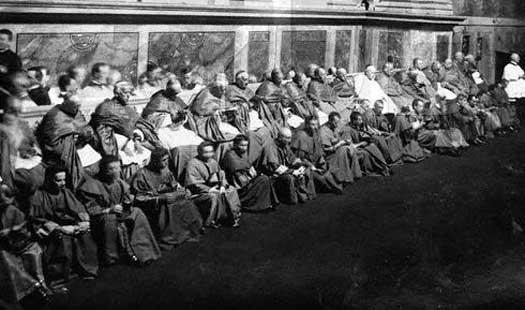 The College of Cardinals (seen here in 1922) was formed in 1061 to elect the pope and has since endured for almost a millennium The College of Cardinals (seen here in 1922) was formed in 1061 to elect the pope and has since endured for almost a millennium |
|
| 1080 - 1085 |
Anti-pope Clement III is appointed by an exasperatedHoly Roman Emperor, Henry IV. The emperor has already been excommunicated twice by Pope Gregory VII for opposing his reforms which will involve a loss of established imperial power over the papacy. In 1084, Henry IV enters Rome and takes direct control of the city, forcing Gregory to retire to Castel Sant'Angelo where he is besieged. Clement is installed as pope in his place. Gregory's death in 1085 solves nothing, as Henry IV and Clement have been driven from Rome by Duke Robert Guiscard of Apulia and Calabria. |
|
| 1085 - 1108 |
Following the withdrawal ofHoly Roman Emperor Henry IV from Rome, a new republic is formed by the city's aristocratic families. During this period, new noble families emerge into positions of power, especially the Frangipane and Vico families. The counts of Tusculum are sidelined by this time. When the prefecture is restored, the Frangipanes are ready to step into the role. |
|
| 1108 - 1143 |
Pierleone Frangipane |
Prefect ofRome. |
| 1108 - 1143 |
Leone Frangipane |
Prefect ofRome. |
| c.1108 - 1126 |
Tolomeo I / Ptolemy I |
Son of Gregory III. Count of Tusculo (Tusculum). |
| 1126 - 1153 |
Tolomeo II / Ptolemy II |
Son. Count of Tusculo (Tusculum). |
| 1143 - 1144 |
Pope Lucius' dealings with Roger II, duke ofApulia and Calabria, lead to a peace of sorts between the Papal States and the Normans in southern Italy, but supply the Roman Senate with the opportunity to reassert its ancient rights. Led by Giordano Pierleoni, a republic is re-established in Rome which seeks to control the Papal States, although the nobility remain neutral in the matter. The Commune of Rome is established, led by Pierleoni. Lucius attempts to force the issue and the Forum is used as a battlefield in which the pope receives a fatal injury. His successor is unable to enter Rome for much of his term in office. However, Pierleoni is deposed by the people after a year in command. |
|
| 1144 - 1145 |
Giordano Pierleoni / Jordanus |
Son of Pierleone Frangipane. Senator ofRome. Deposed. |
| 1146 - 1152 |
Giacomo da Vico |
|
| 1152 - 1158 |
A republic, not controlled by the aristocratic families this time, is formed inRome as Pope Eugenius III arrives from his exile in Tusculum to be formally installed. |
|
| 1153 - c.1167 |
Jonathan |
Son of Tolomeo II. Count of Tusculo (Tusculum). |
| 1153 - 1179 |
Raino |
Brother and joint count of Tusculo (Tusculum). |
| 1158 - 1167 |
Pietro I da Vico |
|
| 1167 - 1178 |
Giovanni da Vico |
|
| 1177 |
Venice offers hospitality to Pope Alexander III and Emperor Frederick Barbarossa, and the republic arbitrates the peace between them following Barbarossa's defeat at Legnano the year before (29 May 1176). Barbarossa renounces his claim to Roman territory and recognises the pope as the city's sovereign prince on 1 August 1177. |
|
| 1186 - 1228 |
Pietro II da Vico |
|
| 1191 |
The number of senatores (senators) in Rome is reduced to one in a thorough reformation of the process of governing the city. From this point on, civil government in Rome is generally handled by the senators rather than the nobility or the papacy. |
|
|
|
|
| Senatores of Rome AD 1191 - 1434 The new communal government in Rome was recognised by Pope Clement III in 1188. In 1191, the number of senatores (senators) in the city was reduced to one in a thorough reformation of the process of governing the city. From this point on, civil government in Rome would be handled by the senators rather than the nobility or the papacy. Later, there were frequently two senators selected to govern together, and usually for a term of just one year. The power-sharing policy was between the Papist Guelf Party, which was led by the Orsini family, and their opponents, the Imperialist Ghibelline Party which was led by the Colonna family. It was a way of allowing each of them to act as a restraint towards the other. (Additional information by William Willems, from Histoire du diocèse et de la principauté de Liége, Joseph Daris (1890-1899, in French), and from External Links: Catholic Encyclopaedia, and Histoire de la Principauté de Liège, Joseph Grandjean (in French), and Les Belges, leur histoire (in French).) |
|
|
| 1191 - 1193 |
Benedetto |
First solo senator ofRome. |
| 1193 - 1195 |
Giovanni Capoccio |
|
| 1195 - 1197 |
Pierleoni Capoccio |
|
| 1197 - 1198 |
The senatorial government ofRome is briefly interrupted when a republic is declared. 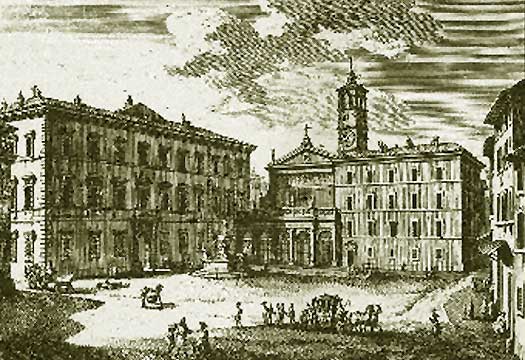 Santa Maria in Trastevere (on the right) was perhaps founded in the third century, restored in the eighth and ninth, and totally rebuilt in the twelfth, much of which survives today Santa Maria in Trastevere (on the right) was perhaps founded in the third century, restored in the eighth and ninth, and totally rebuilt in the twelfth, much of which survives today |
|
| 1198 |
Scotto Paparone |
|
| 1199 - 1204 |
Pandolfo della Suburra |
|
| 1204 |
Gregorio Pierleoni |
|
| 1204 - 1205 |
Feuding between the Pope's family and the Orsinis reaches a head, with rioting in the city and strongholds on either side being besieged. The tumult causes much damage toRome's ancient buildings. |
|
| 1205 - 1207 |
Pandolfo della Suburra |
Restored. |
| 1207 - 1212 |
Giovanni di Leone |
|
| 1212 |
Gentile |
|
| 1212 - 1213 |
Giovanni del Giudice |
|
| 1213 |
Petruccio di Settisolio |
|
| 1214 |
Giovanni degli Alberteschi |
|
| 1215 |
Guido Buonconte |
|
| 1216 |
Pandolfo Giudice |
|
| 1217 |
Nicola di Parenzi |
|
| 1218 |
Lorenzo di Processu |
|
| 1219 |
Stefano Malabranca |
|
| 1220 |
Giacomo di Ottone |
|
| 1220 - 1222 |
Parenzo di Parenzi |
|
| 1222 - 1225 |
Annibale di Buonconte |
|
| 1225 |
Buonconte de' Monaldeschi |
|
| 1225 |
Parenzo di Parenzi |
Restored. |
| 1225 - 1227 |
Angelo de' Benincasa |
|
| 1227 |
Anibaldo degli Anibaldi |
|
| 1228 |
Eude o Ottone |
|
| 1229 |
Ricardo Calisti |
|
| 1229 |
Antonio Calisti |
|
| 1230 - 1231 |
Anibaldo Anibaldi |
|
| 1230 - 1231 |
Giovanni II da Vico |
Prefect ofRome. |
| 1231 - 1233 |
Giovanni de' Poli |
|
| 1233 |
Pandolfo della Suburra |
|
| 1233 |
Gianotto di Oddone |
|
| 1234 - 1235 |
Luca Savelli |
|
| 1235 |
Angelo Malabranca |
|
| 1235 - 1236 |
Giovanni Cenci Frangipane |
|
| 1237 |
Petrasso |
Count of Anguillara. |
| 1237 |
Annibale degli Anibaldi |
|
| 1238 |
Giovanni de' Poli |
Restored. |
| 1238 |
Giovanni Cenci Frangipane |
Restored. |
| 1238 - 1241 |
Giovanni del Giudice |
Podesta of Florence (1234). |
| 1241 |
Annibale degli Anibaldi |
Restored. |
| 1241 |
Oddone Colonna |
|
| 1241 - 1243 |
Matteo Rossi-Orsini |
|
| 1244 - 1262 |
Pietro III |
Count of Anguillara. Prefect ofRome. |
| 1244 - 1245 |
Annibale degli Anibaldi |
|
| 1246 |
Pietro Frangipani |
|
| 1247 |
Bobo di Giovanni |
|
| 1248 - 1249 |
Pietro Anibaldi |
|
| 1248 - 1249 |
Angelo Malabranca |
|
| 1249 - 1252 |
The position of senator inRome is vacant. |
|
| 1252 |
Raimundo Capizuccio |
|
| 1252 - 1254 |
Brancaleone degli Andalò |
Count of Casalecchio. |
| 1255 |
Jacopo Capoccio |
|
| 1255 |
Buonconter de' Monaldeschi |
|
| 1256 |
Martino della Torre |
|
| 1256 - 1257 |
Emanuele de Madio |
|
| 1257 - 1258 |
Brancaleone degli Andalò |
Restored. |
| 1258 - 1259 |
Castellano degli Andalò |
|
| 1259 |
Napoleone Orsini |
|
| 1259 |
Riccardo degli Anibaldi |
|
| 1260 - 1261 |
Giovanni Savelli |
|
| 1260 - 1261 |
Anibaldo Anibaldi |
|
| 1261 - 1263 |
A provisional government managesRome's affairs, following which, in 1263, King Charles I ofSicily is elected senator. |
|
| 1262 - 1268 |
Pietro IV da Vico |
Prefect ofRome. |
| 1263 - 1266 |
Charles I of Anjou |
King ofSicily (1266-1285). King of Hungary (1308-1342). |
| 1266 |
Luca Savelli |
|
| 1267 - 1268 |
A populist government controls the city. The Ghibelline party is crushed at the Battle of Tagliacozzo in 1268, and Charles of Anjou is able to retake control ofRome. 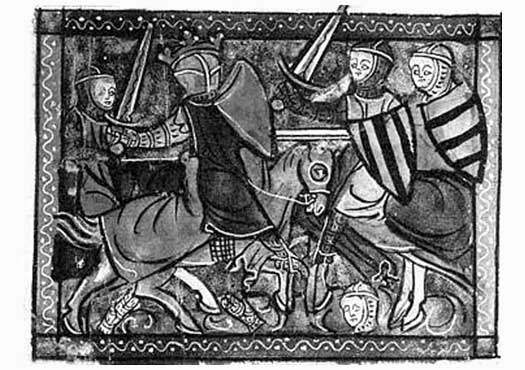 The Battle of Tagliacozzo saw Charles d'Anjou, the Angevin king of Sicily, regain control of Rome in his role as a senator of the city's civil government The Battle of Tagliacozzo saw Charles d'Anjou, the Angevin king of Sicily, regain control of Rome in his role as a senator of the city's civil government |
|
| 1268 - 1278 |
Charles I of Anjou |
Restored. Now also king ofAlbania (1272-1285). |
| 1272 |
The much-travelled Charles of Anjou has spent a year carving out a territory which, in essence, replicates the former principality of Arbanon. It had taken a further five years of diplomacy to be accepted by theAlbanians themselves, following which he is declared king of Albania in 1272. This ties it in personal union Charles' kingdom ofNaples.  The energetic Charles I, best known as Charles of Anjou, was a member of the royal Capetian dynasty and founder of the second 'House of Anjou', count of Provence and Forcalquier within the Holy Roman empire, count of Anjou and Maine in France, king of Sicily, prince of Achaea, and king of Albania The energetic Charles I, best known as Charles of Anjou, was a member of the royal Capetian dynasty and founder of the second 'House of Anjou', count of Provence and Forcalquier within the Holy Roman empire, count of Anjou and Maine in France, king of Sicily, prince of Achaea, and king of Albania |
|
| 1272 - 1302 |
Pietro V da Vico |
Prefect ofRome. |
| 1278 |
Matteo Rossi-Orsini II |
|
| 1279 - 1280 |
Giovanni Colonna |
|
| 1279 - 1280 |
Pandolfo Savelli |
|
| 1281 - 1284 |
Charles I of Anjou |
Restored for a second time. |
| 1284 |
Annibale Annibaldi |
|
| 1284 - 1285 |
Pandolfo Savelli |
Restored. |
| 1285 |
Annibale Transmundo |
|
| 1286 - 1287 |
Gentile Orsini |
|
| 1288 - 1289 |
Bertoldo Orsini |
|
| 1288 |
Orso Orsini I |
|
| 1288 - 1290 |
Niccolò de' Conti |
|
| 1290 |
Luca Savelli |
|
| 1290 |
Giovanni Colonna |
Lord ofRome. |
| 1291 |
Pandolfo Savelli |
Restored for a second time. |
| 1292 |
Stefano Colonna |
Count of Romagna. |
| 1292 |
Matteo Rinaldo |
|
| 1293 |
Agapito Colonna |
|
| 1293 |
- Orsini |
First name unknown. |
| 1293 - 1294 |
Pietro Rainieri de' Stefaneschi |
|
| 1293 - 1294 |
Eude di San Eustacchio |
|
| 1294 |
Tommaso da San Severino |
Count of Marsico. |
| 1295 |
Ugolino de' Rossi |
|
| 1296 |
Pietro de' Stefaneschi |
|
| 1296 |
Andrea Romano |
|
| 1297 - 1298 |
Pandolfo Savelli |
Restored for a third time. |
| 1298 |
Eude o Oddone |
|
| 1298 - 1300 |
The position of senator inRome is vacant. |
|
| 1300 |
Riccardo Annibaldi |
|
| 1300 |
Gentile Orsini |
|
| 1300 - 1302 |
The position of senator inRome is again vacant. |
|
| 1302 |
Giacomo Napoleone Orsini |
|
| 1302 |
Matteo Rinaldi Orsini |
|
| 1303 |
Guido de Pileo |
|
| 1303 |
Tebaldo Orsini |
|
| 1303 |
Alessio Bonaventura |
|
| 1304 |
Gentile Orsini |
|
| 1304 |
Luca Savelli |
|
| 1305 - 1306 |
Paganino della Torre |
|
| 1305 - 1377 |
[Pope](ItalyPopes.htm#Great Schism) Clement V resides at Poitiers for the first four years of his papacy, before moving to an enclave in Avignon (now inFrance but at this time part of the lands of Frederick I, king ofSicily), in a period known as the Babylonian Captivity. This starts a period of decline in Rome, with no new building work being initiated, and many monuments and churches falling slowly into ruin. |
|
| 1306 |
Gentile Orsini |
Restored. |
| 1306 |
Stefano Colonna II |
|
| 1307 |
Pietro Savelli |
|
| 1307 |
Giovanni Normanni |
|
| 1307 |
Giovanni Cerese |
|
| 1307 - 1308 |
Ricardo degli Annibaldi |
|
| 1307 - 1308 |
Giovanni Colonna |
|
| 1308 |
Giacomo Sciarra Colonna |
|
| 1308 |
Giacomo Savelli |
|
| 1308 - 1337 |
Manfred da Vico |
Prefect of[Rome](ItalyPopes.htm#Great Schism). |
| 1309 |
Giovanni Pietro de' Stefaneschi |
|
| 1309 |
Tebaldo di San Eustachio |
|
| 1312 |
Francesco Orsini |
|
| 1312 |
Giacomo Sciarra Colonna |
|
| 1312 - 1313 |
 A populist revolt ousts the senators temporarily. TheHoly Roman empire's Henry VII travels to Rome in May 1312 to be crowned, accompanied by Theobald of Bar, prince-bishop of Liège (see feature link). Henry decides he wants to conquer Rome and Theobald is participating with him in street fights against Robert of Anjou, king ofNaples, when he is fatally wounded. The prince-bishop dies in Rome, sword in hand. A populist revolt ousts the senators temporarily. TheHoly Roman empire's Henry VII travels to Rome in May 1312 to be crowned, accompanied by Theobald of Bar, prince-bishop of Liège (see feature link). Henry decides he wants to conquer Rome and Theobald is participating with him in street fights against Robert of Anjou, king ofNaples, when he is fatally wounded. The prince-bishop dies in Rome, sword in hand. |
|
| 1313 |
Francesco Orsini |
Restored. |
| 1313 |
Giacomo Sciarra Colonna |
Restored. |
| 1314 - 1326 |
Robert d'Anjou |
King ofNaples (1309-1343). |
| 1327 - 1328 |
[Pope](ItalyPopes.htm#Great Schism) John XXII has already opposed Louis IV of [ Bavaria](GermanyBavarians.htm#Duchy of Bavaria %28Wittelsbachs%29) asHoly Roman emperor, so the Bavarian king invades [Italy](ItalyKingdom.htm#Lords of Milan) and sets up Nicholas V as a short-lived anti-pope. Fortunately, the successor of John XXII is much more conciliatory. 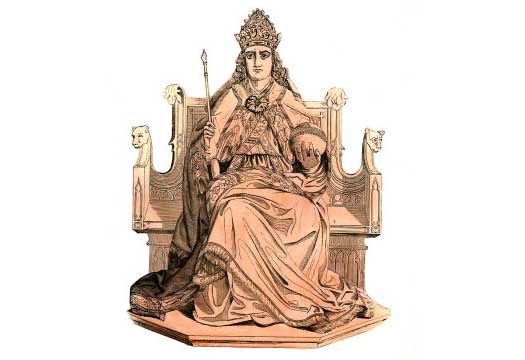 The vigorous king of Bavaria and HRE Louis IV also became king of Italy in 1327 despite many objections and opposition figures, with his strength of will and character being proof of his desire and eligibility to rule The vigorous king of Bavaria and HRE Louis IV also became king of Italy in 1327 despite many objections and opposition figures, with his strength of will and character being proof of his desire and eligibility to rule |
|
| 1328 |
Louis IV Wittelsbach |
Duke of[ Bavaria](GermanyBavarians.htm#Duchy of Bavaria %28Wittelsbachs%29) (1294-1347) &HRE (1314-1347). |
| 1328 |
Castruccio Castracani |
Lord of Pisa & Lucca. |
| 1328 |
Rainiero della Faggiuola |
|
| 1328 |
Bertoldo Orsini |
|
| 1328 |
Stefano Colonna |
|
| 1328 - 1335 |
Robert d'Anjou |
Restored. |
| 1335 |
Riccardo Fortebraccio |
|
| 1335 |
Giacomo Colonna |
|
| 1335 - 1337 |
The position of senator in[Rome](ItalyPopes.htm#Great Schism) is vacant. |
|
| 1337 |
Stefano Colonna |
|
| 1337 |
Orso dell'Anguillara |
|
| 1337 |
Giacomo di Cante dei Gabrielli |
|
| 1337 |
Bosone Novello dei Raffaelli da Gubbio |
|
| 1338 - 1339 |
Matteo Orsini |
|
| 1338 - 1339 |
Pietro Colonna |
|
| 1339 - 1342 |
Disorder by the populace of[Rome](ItalyPopes.htm#Great Schism) disturbs the city. Rule by two senators is reintroduced. |
|
| 1340 |
Tebaldo di San Eustachio |
|
| 1340 |
Martino de' Stefaneschi |
|
| 1341 |
Orso dell'Anguillara |
|
| 1341 |
Giordano Orsini |
|
| 1341 |
Francesco Orsini |
|
| 1341 |
Paolo Niccolo degli Annibaldi |
|
| 1341 |
Francesco Savelli |
|
| 1342 - 1352 |
Pope Clement VI |
Senator of[Rome](ItalyPopes.htm#Great Schism) for Life. |
| 1343 - 1344 |
Matteo Orsini |
|
| 1343 - 1344 |
Paolo Conti |
|
| 1344 |
Giordano Orsini |
|
| 1344 |
Giovanni Colonna |
|
| 1345 |
Bertoldo Orsini |
|
| 1345 |
Orso dell'Anguillara |
|
| 1345 |
Rainaldo Orsini |
|
| 1345 |
Nicola Anibaldi |
|
| 1346 |
Orso Orsini |
|
| 1346 |
Nicola Conti |
|
| 1346 |
Nicola Annibaldi |
Restored. |
| 1346 |
Giordano Orsini |
|
| 1347 |
Roberto Orsini |
|
| 1347 |
Pietro Colonna |
|
| 1347 |
Cola de Rienzo, an impassioned student of the Bible, believes that he has a divinely inspired mission to revive the ancient glories of[Rome](ItalyPopes.htm#Great Schism). He marches to the Capitol, surrounded by his adherents, and convokes a parliament of the people. Unfortunately, his head is turned by his sudden success and he quickly develops into a tyrant who is soon deposed. |
|
| 1347 |
Cola Rienzo / Rienzi |
Tribune. Dictator of[Rome](ItalyPopes.htm#Great Schism) (May-Dec). |
| 1347 - 1350 |
The Black Death rips through Europe, killing about a third of its population. This has a major effect on the economy and on working practices, especially in England where the decimated peasant workforce is now able to demand freedom and pay for its services. TheJews are popularly blamed for the epidemic, but [Pope](ItalyPopes.htm#Great Schism) Clement VI issues two papal bulls and urges the clergy to protect Jews. 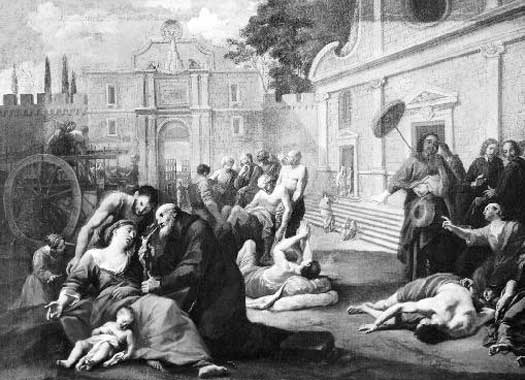 The Black Death ripped through Europe, killing perhaps one third of its entire population in just two or three years, but the plague also paved the way for great social changes as the reduced workforce was now in a position of negotiating power The Black Death ripped through Europe, killing perhaps one third of its entire population in just two or three years, but the plague also paved the way for great social changes as the reduced workforce was now in a position of negotiating power |
|
| 1348 |
Bertoldo Orsini |
|
| 1348 |
Luca Savelli |
|
| 1349 |
Nicola de Zancato |
|
| 1349 |
Guido Francesco Orsini |
|
| 1350 |
Pietro Colonna Giordani |
|
| 1350 |
Giovanni Orsini |
|
| 1350 - 1351 |
Rinaldo Orsini |
|
| 1350 - 1351 |
Stefanello Colonna |
|
| 1351 |
Further revolts by the populace of the city disrupts the senatorial governorship of[Rome](ItalyPopes.htm#Great Schism). A popular government is formed in order to complete the exclusion of the nobles. |
|
| 1351 - 1352 |
Giovanni Cerroni |
Captain. Dictator of[Rome](ItalyPopes.htm#Great Schism). |
| 1352 |
Bertoldo Orsini |
|
| 1352 |
Stefanello Colonna |
Restored. |
| 1352 |
Giovanni Orsini |
|
| 1352 |
Pietro Sciarra |
|
| 1352 - 1353 |
The people of[Rome](ItalyPopes.htm#Great Schism) revolt in 1352 and Francesco Baroncelli gains power as dictator. He is rapidly overthrown. The supremacy of the senate is granted to the pope, and Guido Patrizi is nominated as senator. |
|
| 1353 |
Francesco Baroncelli |
Tribune. Dictator of[Rome](ItalyPopes.htm#Great Schism). |
| 1353 - 1354 |
Guido Giordani Patrizi |
|
| 1354 |
Cola Rienzi |
Restored. |
| 1355 |
Orso Andrea Orsini |
|
| 1355 |
Giovanni Tebaldi |
|
| 1355 |
Luca Savelli |
|
| 1355 |
Francesco Orsini |
|
| 1356 |
Sciarra Colonna |
|
| 1356 |
Nicola Orsini |
|
| 1356 |
Orso Capoccio |
|
| 1356 |
Pietro Capoccio |
|
| 1357 |
Pietro Giordani Colonna |
|
| 1357 |
Nicola Riccardi degli Anibaldi |
|
| 1358 - 1362 |
Pope Innocent VI |
Senator of[Rome](ItalyPopes.htm#Great Schism) for Life. |
| 1358 |
Raimondi de' Tolomei |
|
| 1359 |
Luigi Rocca |
|
| 1359 |
Ungaro de Sassoferrato |
|
| 1360 |
Tommaso de Planciano |
|
| 1361 |
Hugh de Lusignan |
|
| 1361 |
Paolo de Argento |
Count of Campello. |
| 1362 |
Lazzaro de' Cancelliari |
|
| 1363 |
Rosso de' Ricci |
|
| 1363 |
Guelfo di Bostenti |
|
| 1363 |
Bonifacio Ricciardi |
|
| 1364 - 1365 |
Francesco Ugolini degli Arcipreti |
|
| 1365 - 1367 |
Three thousand men, mostly archers, are enrolled under the command of two banderesi. with four antepositi constituting a supreme council of war. As a whole, the body is styled the 'Felix Societas Balestrariorum et Pavesatorum'. It is instituted to support the reformers and re-establish order in[Rome](ItalyPopes.htm#Great Schism) and the Campagna, to keep down the nobles and defend the republic. It fulfils these duties severely, sometimes too severely. Its power is temporarily suspended by the return of the pope to the city and his assumption of supreme authority. |
|
| 1367 |
Biagio Fernando de Belvisio |
|
| 1367 |
Berardo Monaldeschi |
|
| 1368 |
Bertrando de' Rainardi |
|
| 1368 |
Gentile da Varano |
|
| 1369 |
Luigi de Sabran |
Count d'Ariano. |
| 1369 - 1370 |
Bernardo Corrado de' Monaldeschi |
|
| 1371 - 1372 |
With Urban V leaving the city again shortly before his death, having failed to fully establish himself, a second period of banderesi government controls[Rome](ItalyPopes.htm#Great Schism). |
|
| 1372 |
Raimundo de' Tolomei |
|
| 1373 |
Pietro de Marina |
|
| 1373 |
Fortunato Rainoldi |
|
| 1374 |
Antonio da San Raimundo |
|
| 1375 |
Francesco |
Count of Campello. |
| 1376 |
Simeone de' Tommasi |
|
| 1376 - 1377 |
A third period of banderesi government controls Rome until[Pope](ItalyPopes.htm#Great Schism) Gregory XI ends the Babylonian Captivity by restoring the papacy to its traditional seat in the city. His death the following year leads to the Roman mob breaking into the College of Cardinals to insist on the election of an Italian pontiff. 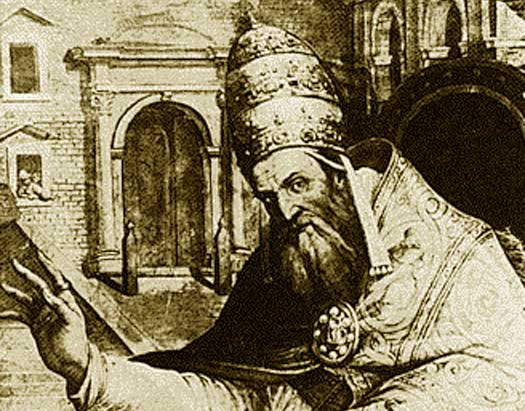 Pope Gregory XI ended the Babylonian Captivity by bringing the papacy back to Rome, where it has remained ever since, but this seemingly encouraged the Roman populace to insist on an Italian pontiff to succeed him Pope Gregory XI ended the Babylonian Captivity by bringing the papacy back to Rome, where it has remained ever since, but this seemingly encouraged the Roman populace to insist on an Italian pontiff to succeed him |
|
| 1377 |
Gomez Albornoz |
|
| 1377 |
Guido de Prohinis |
|
| 1378 |
Tommaso da San Severino |
|
| 1378 - 1379 |
The government of[Rome](ItalyPopes.htm#Great Schism), ever turbulent, forms another short-lived period of banderesi government in opposition to the pope's authority. |
|
| 1382 |
Tommaso Minoti |
|
| 1383 - 1389 |
During the discord engendered by the difficult Pope Urban VI, a banderesi government controls civil affairs in[Rome](ItalyPopes.htm#Great Schism). The pope excommunicates the banderesi and they eventually submit to him, making him master of the city shortly before his death in 1389. |
|
| 1389 |
Damiano Cattaneo |
|
| 1389 - 1391 |
[Pope](ItalyPopes.htm#Great Schism) Urban's successor fails to control the banderesi, the time taken to appoint a senator being part of the problem. A short period of government by banderesi is resolved in 1391. |
|
| 1391 - 1392 |
Giovanni Cenci |
|
| 1393 - 1398 |
Pope Boniface's relations with[Rome](ItalyPopes.htm#Great Schism) decline rapidly when the banderesi discover that he intends to keep all recently conquered territory for himself, rather than appoint it to Rome's keeping. A riot breaks out and the pope is forced to flee to Perugia in October 1392. Eventual agreement is reached which allows the pope to elect the senator, and if he fails to do so the conservators will carry on the government after swearing fealty to him. The senatorial function will not be controlled or hampered by the banderesi. The immunities of the clergy are to be preserved, and all church property is to be respected by the magistrates. When a plot to re-establish the banderesi is discovered in 1398, the ringleaders are beheaded, ending the banderesi threat once and for all. |
|
| 1399 |
Angelo Alaleoni |
|
| 1399 |
Zaccaria Trevisano |
|
| 1400 |
Benuttino Cima |
|
| 1400 |
Bartolomeo Carafa |
|
| 1401 |
Pier Francesco de' Brancaleoni |
|
| 1401 |
Antonio Avuti |
Count of Monteverde. |
| 1402 |
Pier Francesco de' Brancaleoni |
Restored. |
| 1403 |
Riccardo d'Agnello |
|
| 1404 |
Giacomo di Montedolce |
|
| 1405 |
Bente dei Bentivogli |
|
| 1405 |
Francesco Panciatichi |
|
| 1406 - 1407 |
Pier Francesco de' Brancaleoni |
|
| 1407 |
Giovanni Cima da Cingoli |
|
| 1408 - 1410 |
Ladislas |
King ofNaples (1386-1414). Lord of [Rome](ItalyPopes.htm#Great Schism) from 1408. |
| 1408 - 1410 |
Gianezzo Torti |
|
| 1410 - 1411 |
Ruggero |
Count of Antigliola. |
| 1411 - 1412 |
Ricardo degli Alidosi |
|
| 1413 |
Felcino di Hermannis |
Count of Monte Giuliano. |
| 1413 - 1414 |
Ladislas |
King of Naples, restored as lord of [Rome](ItalyPopes.htm#Great Schism). |
| 1413 - 1414 |
Niccolò de Diano |
|
| 1414 |
Giovanni Torti |
|
| 1414 |
Antonio de' Grassi |
|
| 1415 |
Ricardo degli Alidosi d'Imola |
|
| 1416 |
Giovanni Alidosi |
|
| 1417 |
Ruggero |
Restored. Count of Antigliola. |
| 1417 - 1418 |
Giovanni Spinelli |
|
| 1419 |
Ranuccio Farnese |
|
| 1420 |
Nerio Vitori |
|
| 1420 |
Baldassare |
Count of Bardella d'Imola. |
| 1421 |
Stefano de' Branchis |
|
| 1421 |
Nicolai Salerno |
|
| 1422 |
Bartolomeo Gonzaga |
Podesta of Florence (1403). |
| 1422 - 1434 |
Following the papal seizure of[Rome](ItalyPopes.htm#Great Schism) and many other Italian cities, and much destruction, the old senatorial arrangement in the city is finally abandoned. The pope controls the civil government of the city, restoring peace and security but removing liberty. |
|
| 1434 - 1798 |
One last revolt by the people of Rome leads to a wholesale slaughter of the ring-leaders, ensuring the final death of the old system. The papacy assumes what is effectively direct control of the city's governance. Day-to-day administrative duties are delegated mostly to the College of Cardinals and various papal departments. This arrangement manages to survive until the invasion of [French](FranceFranks.htm#First Republic) General Napoleon Bonaparte at the end of the eighteenth century. |
|
| 1796 - 1800 |
Republican [France](FranceFranks.htm#First Republic) begins the conquest of[ Austria](GermanyAustria.htm#Habsburg Archdukes %28Lorraine%29)'s territories inItaly. Rome is occupied by force, briefly, by Naples in 1798. A Roman republic is proclaimed at the end of the year (1798-1799), using the territory of the Papal States. The pope is required to renounce his temporal authority, and when he refuses he is taken prisoner. He is taken off into captivity by the French and dies shortly after his arrival in Valence. Austrian victories in Italy force the French to withdraw from Rome. 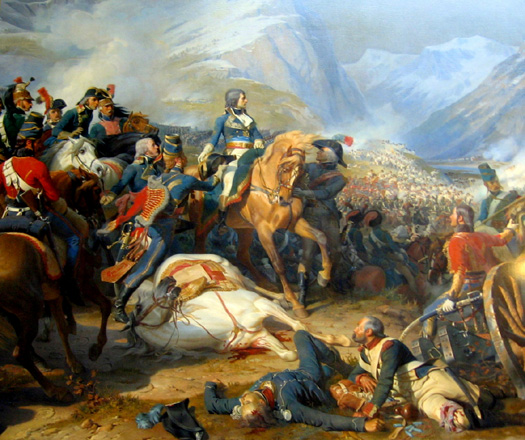 Napoleon commands at the Battle of Rivoli, which took place between 14-15 January 1797, and was the first French campaign in Italy against Austria, one of a series in the years to follow Napoleon commands at the Battle of Rivoli, which took place between 14-15 January 1797, and was the first French campaign in Italy against Austria, one of a series in the years to follow |
|
| 1801 |
A Concordat is agreed with[French](FranceFranks.htm#First Republic) First Consul Napoleon Bonaparte to restore the links between Rome and the French Church. However, the Peace of Luneville in the same year compensates several German princes for losses of territory by assigning to them ecclesiastical land inGermany taken from the Pope. |
|
| 1808 - 1814 |
With relations between[French](FranceFranks.htm#First Empire) Emperor Napoleon Bonaparte and the Pope deteriorating rapidly in 1808, Rome is occupied by a division of French troops. The following year the remaining Papal States are annexed to the French-controlled kingdom ofItaly, including ancient Spoleto. When Pius VII subsequently excommunicates Napoleon, the French capture Castel Sant'Angelo, and a French officer breaks into the papal residence and kidnaps the pope himself. The pope remains a French captive for six years, being moved around Europe to various holding points. |
|
| 1814 - 1815 |
Napoleon Bonaparte is exiled to Elba and the Pope regains control of Rome and its associated territories. In 1815, following a brief period of occupation by Joachim Murat, king of [ Naples](ItalyNaples.htm#Kingdom of Naples), Napoleon is permanently removed from European politics.[Austria](GermanyAustria.htm#Habsburg Emperors) renews its control of northern [Italy](ItalyKingdom.htm#Austria Restored), and the Papal States are restored to Rome. |
|
| 1859 - 1866 |
During 1859-1861, Italy is forged by nationalist Giuseppe Garibaldi into a single kingdom during the War of Unification, freeing Italy from [Austrian](GermanyAustria.htm#Habsburg Emperors) control. The Savoyard king of Sardinia becomes king of Italy (a title previously held by the Holy Roman Emperors), gaining Parma, [Sicily & Naples](ItalySicily.htm#Two Sicilies Reunited), and Spoleto, but at the same time losing Savoy to [France](FranceFranks.htm#Second Empire). In 1866 Venice is annexed and added to Italy, while much of the Papal States has already been absorbed by this date. |
|
| 1870 - 1871 |
With the seizure of Rome in 1870, Italy achieves full union under the House of Savoy. The following year, Rome becomes its capital for the first time since the collapse of the WesternRoman empire, and the last vestiges of the Papal States are absorbed into the new kingdom. |
|
| 1929 |
The pope and Mussolini sign the Lateran Treaty, finally settling the breach between the Italian government and the papacy that has existed since the seizure of the Papal States in 1870. The treaty establishes the independent Vatican City State in Rome. |
|
 |
|
|

 This romantic painting shows the amphitheatre of the Italian city of Tusculum, native territory of the influential counts of Tusculum who dominated the early post-Frankish Roman civil authority
This romantic painting shows the amphitheatre of the Italian city of Tusculum, native territory of the influential counts of Tusculum who dominated the early post-Frankish Roman civil authority The College of Cardinals (seen here in 1922) was formed in 1061 to elect the pope and has since endured for almost a millennium
The College of Cardinals (seen here in 1922) was formed in 1061 to elect the pope and has since endured for almost a millennium Santa Maria in Trastevere (on the right) was perhaps founded in the third century, restored in the eighth and ninth, and totally rebuilt in the twelfth, much of which survives today
Santa Maria in Trastevere (on the right) was perhaps founded in the third century, restored in the eighth and ninth, and totally rebuilt in the twelfth, much of which survives today The Battle of Tagliacozzo saw Charles d'Anjou, the Angevin king of Sicily, regain control of Rome in his role as a senator of the city's civil government
The Battle of Tagliacozzo saw Charles d'Anjou, the Angevin king of Sicily, regain control of Rome in his role as a senator of the city's civil government The energetic Charles I, best known as Charles of Anjou, was a member of the royal Capetian dynasty and founder of the second 'House of Anjou', count of Provence and Forcalquier within the Holy Roman empire, count of Anjou and Maine in France, king of Sicily, prince of Achaea, and king of Albania
The energetic Charles I, best known as Charles of Anjou, was a member of the royal Capetian dynasty and founder of the second 'House of Anjou', count of Provence and Forcalquier within the Holy Roman empire, count of Anjou and Maine in France, king of Sicily, prince of Achaea, and king of Albania A populist revolt ousts the senators temporarily. TheHoly Roman empire's Henry VII travels to Rome in May 1312 to be crowned, accompanied by Theobald of Bar, prince-bishop of Liège (see feature link). Henry decides he wants to conquer Rome and Theobald is participating with him in street fights against Robert of Anjou, king ofNaples, when he is fatally wounded. The prince-bishop dies in Rome, sword in hand.
A populist revolt ousts the senators temporarily. TheHoly Roman empire's Henry VII travels to Rome in May 1312 to be crowned, accompanied by Theobald of Bar, prince-bishop of Liège (see feature link). Henry decides he wants to conquer Rome and Theobald is participating with him in street fights against Robert of Anjou, king ofNaples, when he is fatally wounded. The prince-bishop dies in Rome, sword in hand. The vigorous king of Bavaria and HRE Louis IV also became king of Italy in 1327 despite many objections and opposition figures, with his strength of will and character being proof of his desire and eligibility to rule
The vigorous king of Bavaria and HRE Louis IV also became king of Italy in 1327 despite many objections and opposition figures, with his strength of will and character being proof of his desire and eligibility to rule The Black Death ripped through Europe, killing perhaps one third of its entire population in just two or three years, but the plague also paved the way for great social changes as the reduced workforce was now in a position of negotiating power
The Black Death ripped through Europe, killing perhaps one third of its entire population in just two or three years, but the plague also paved the way for great social changes as the reduced workforce was now in a position of negotiating power Pope Gregory XI ended the Babylonian Captivity by bringing the papacy back to Rome, where it has remained ever since, but this seemingly encouraged the Roman populace to insist on an Italian pontiff to succeed him
Pope Gregory XI ended the Babylonian Captivity by bringing the papacy back to Rome, where it has remained ever since, but this seemingly encouraged the Roman populace to insist on an Italian pontiff to succeed him Napoleon commands at the Battle of Rivoli, which took place between 14-15 January 1797, and was the first French campaign in Italy against Austria, one of a series in the years to follow
Napoleon commands at the Battle of Rivoli, which took place between 14-15 January 1797, and was the first French campaign in Italy against Austria, one of a series in the years to follow